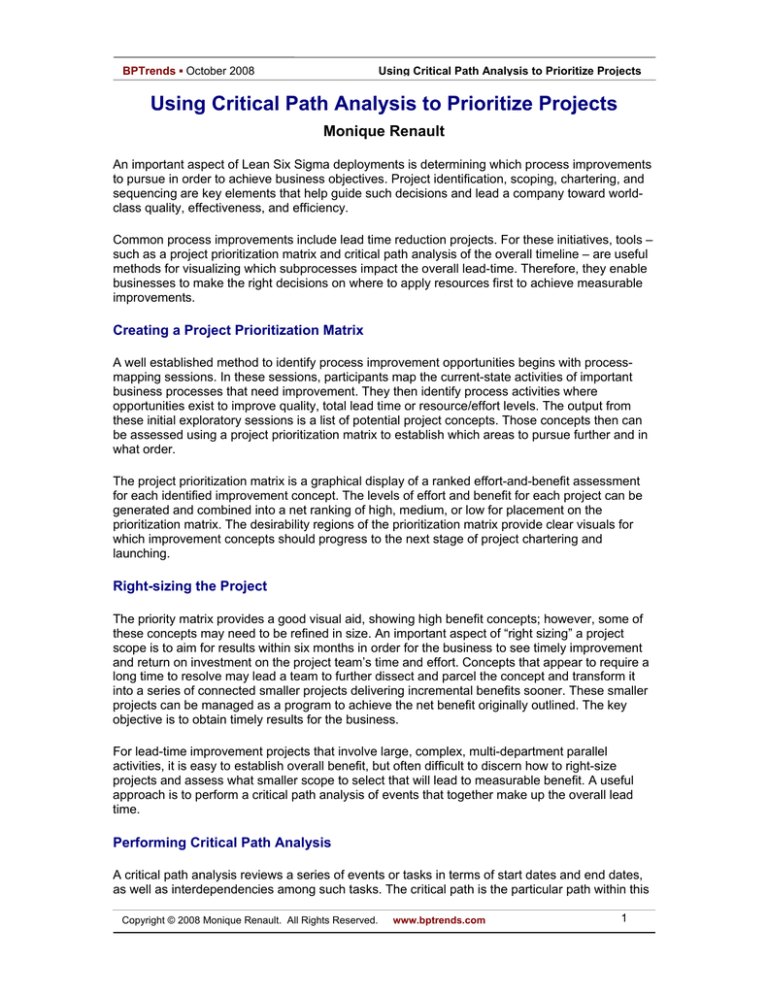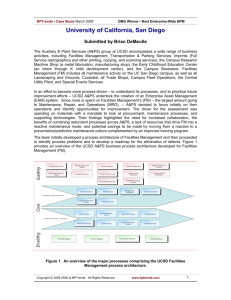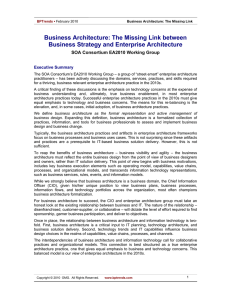
BPTrends ▪ October 2008
Using Critical Path Analysis to Prioritize Projects
Using Critical Path Analysis to Prioritize Projects
Monique Renault
An important aspect of Lean Six Sigma deployments is determining which process improvements
to pursue in order to achieve business objectives. Project identification, scoping, chartering, and
sequencing are key elements that help guide such decisions and lead a company toward worldclass quality, effectiveness, and efficiency.
Common process improvements include lead time reduction projects. For these initiatives, tools –
such as a project prioritization matrix and critical path analysis of the overall timeline – are useful
methods for visualizing which subprocesses impact the overall lead-time. Therefore, they enable
businesses to make the right decisions on where to apply resources first to achieve measurable
improvements.
Creating a Project Prioritization Matrix
A well established method to identify process improvement opportunities begins with processmapping sessions. In these sessions, participants map the current-state activities of important
business processes that need improvement. They then identify process activities where
opportunities exist to improve quality, total lead time or resource/effort levels. The output from
these initial exploratory sessions is a list of potential project concepts. Those concepts then can
be assessed using a project prioritization matrix to establish which areas to pursue further and in
what order.
The project prioritization matrix is a graphical display of a ranked effort-and-benefit assessment
for each identified improvement concept. The levels of effort and benefit for each project can be
generated and combined into a net ranking of high, medium, or low for placement on the
prioritization matrix. The desirability regions of the prioritization matrix provide clear visuals for
which improvement concepts should progress to the next stage of project chartering and
launching.
Right-sizing the Project
The priority matrix provides a good visual aid, showing high benefit concepts; however, some of
these concepts may need to be refined in size. An important aspect of “right sizing” a project
scope is to aim for results within six months in order for the business to see timely improvement
and return on investment on the project team’s time and effort. Concepts that appear to require a
long time to resolve may lead a team to further dissect and parcel the concept and transform it
into a series of connected smaller projects delivering incremental benefits sooner. These smaller
projects can be managed as a program to achieve the net benefit originally outlined. The key
objective is to obtain timely results for the business.
For lead-time improvement projects that involve large, complex, multi-department parallel
activities, it is easy to establish overall benefit, but often difficult to discern how to right-size
projects and assess what smaller scope to select that will lead to measurable benefit. A useful
approach is to perform a critical path analysis of events that together make up the overall lead
time.
Performing Critical Path Analysis
A critical path analysis reviews a series of events or tasks in terms of start dates and end dates,
as well as interdependencies among such tasks. The critical path is the particular path within this
Copyright © 2008 Monique Renault. All Rights Reserved.
www.bptrends.com
1
BPTrends ▪ October 2008
Using Critical Path Analysis to Prioritize Projects
mesh of events that can account for the final overall lead time. Events or tasks not on the critical
path have what is called “float” time, whereby they could have happened slightly earlier or later
and the overall lead-time would not have changed. It is important to identify project opportunities
on the critical path in order to reduce the overall lead time. Project opportunities in process areas
not on the critical path will reduce the duration of the subprocess, but result in increased float time
rather than impacting total lead time.
Method
A baseline of past activities and outcomes should contain the following three elements of
information:
1. A list of all activities required to complete the overall outcome
2. The start and end time of each activity
3. The dependencies between the activities
Figure 1. Flow of Inputs, Department Activities, and Outputs
Consider the example of a department receiving a package of inputs at various points in time,
carrying out activities and delivering a package of outputs where the final output element defines
the total lead time of the associated process. The example is displayed graphically in Figure 2, in
Gantt chart style.
Figure 2. Input, Activity, and Output within Sample Department
Copyright © 2008 Monique Renault. All Rights Reserved.
www.bptrends.com
2
BPTrends ▪ October 2008
Using Critical Path Analysis to Prioritize Projects
A color-coded legend indicates which events are driven from outside the scope of control of a
particular department (green), the departmental activities (blue), and the final outcomes/outputs
(purple). The arrows indicate interdependencies, where an event has to begin or conclude before
another event can begin or conclude.
A critical path analysis is carried out by starting at the last output and tracing the upstream path of
prerequisite events, then moving to the immediately preceding output and repeating the upstream
path (Figure 3). For this example, the critical path is shown in red. Events not on the critical path
have the ability to float. It is important to be aware of these float activities as it may be an
indicator that resources could be shifted to critical path items to manage the overall timeline.
Figure 3. Input, Activity, and Output With Critical Path Outlined
Copyright © 2008 Monique Renault. All Rights Reserved.
www.bptrends.com
3
BPTrends ▪ October 2008
Using Critical Path Analysis to Prioritize Projects
Drawing Conclusions from the Path
This example illustrates how to use critical path analysis to guide project prioritization to affect
overall lead-time. The suggested priorities are illustrated in Table 1.
Table 1. Improvement Opportunities
Critical
Path
Charter
External
Department
to Charter
Department
inp2
Reduce lead time
completing inp2
of
Within
act2
Reduce lead time
completing act2
of
act3
Reduce lead time
completing act3
of
Reduce lead time
completing act7
of
inp4
Reduce lead time
completing inp4
act7
of
There is some risk with this approach if a change of events causes a change in the critical path.
For example, changes in resource allocation could affect departmental timing, the duration of
activities, or different timing of an incoming event. This would result in the identified improvement
projects enabling more float in that subprocess rather than having immediate impact on the
overall lead time.
Driving Business Results
In this example, a critical path analysis has allowed the business to narrow improvement
opportunities from potential projects on four inputs plus seven activities, or 11 total project
opportunities to five opportunities, effectively achieving a 55 percent narrowing of initiatives. This
will impact the immediate business objective of total lead-time reduction.
Critical path analysis offers a useful approach and rationale for prioritizing improvement
opportunities within a complex process space. On a journey of continuous improvement, every
subprocess improvement is a valid exercise. The right projects, selected through critical path
analysis, add up to demonstrable business improvements to total overall lead time.
________
Author
Monique Renault is a Master Black Belt with the Business Process Improvement group of MDS
Inc., a global life sciences company. She can be reached at monique.renault@mdsinc.com.
Copyright © 2008 Monique Renault. All Rights Reserved.
www.bptrends.com
4
BPTrends ▪ October 2008
Using Critical Path Analysis to Prioritize Projects
Terms of Service. Copyright © 2000-2008 iSixSigma. All rights reserved. Visit us at
http://www.iSixSigma.com.
Copyright © 2008 Monique Renault. All Rights Reserved.
www.bptrends.com
5








